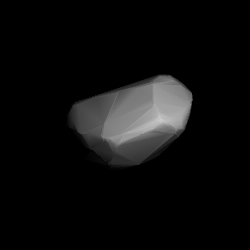Astronomy:1431 Luanda
 Modelled shape of Luanda from its lightcurve | |
| Discovery[1] | |
|---|---|
| Discovered by | C. Jackson |
| Discovery site | Johannesburg |
| Discovery date | 29 July 1937 |
| Designations | |
| (1431) Luanda | |
| Named after | Luanda[2] (Capital of Angola) |
| 1937 OB · 1949 KZ | |
| Minor planet category | main-belt · (middle) Eunomia[3][4] |
| Orbital characteristics[1] | |
| Epoch 4 September 2017 (JD 2458000.5) | |
| Uncertainty parameter 0 | |
| Observation arc | 80.22 yr (29,300 days) |
| |{{{apsis}}}|helion}} | 3.0989 AU |
| |{{{apsis}}}|helion}} | 2.1408 AU |
| 2.6199 AU | |
| Eccentricity | 0.1829 |
| Orbital period | 4.24 yr (1,549 days) |
| Mean anomaly | 293.57° |
| Mean motion | 0° 13m 56.64s / day |
| Inclination | 13.987° |
| Longitude of ascending node | 117.73° |
| 224.19° | |
| Physical characteristics | |
| Dimensions | 13.608±1.966 km[5] 13.88 km (calculated)[3] |
| Rotation period | 4.141±0.004 h[6] 5.360±0.002 h[7] |
| Geometric albedo | 0.21 (assumed)[3] 0.360±0.347[5] |
| LS [8] · S (assumed)[3] | |
| Absolute magnitude (H) | 11.06[5] · 11.6[3] · 11.7[1] · 12.38±0.42[8] |
1431 Luanda, provisional designation 1937 OB, is a stony Eunomian asteroid from the central regions of the asteroid belt, approximately 14 kilometers in diameter. It was discovered on 29 July 1937, by South African astronomer Cyril Jackson at the Union Observatory in Johannesburg.[9] The asteroid was named after the city of Luanda.[2]
Orbit and classification
Luanda is a member of the Eunomia family (502),[4] a prominent family of stony S-type asteroid and the largest one in the intermediate main belt with more than 5,000 members.[10]:23 It orbits the Sun in the central asteroid belt at a distance of 2.1–3.1 AU once every 4 years and 3 months (1,549 days). Its orbit has an eccentricity of 0.18 and an inclination of 14° with respect to the ecliptic.[1] The body's observation arc begins with its official discovery observation at Johannesburg in 1937.[9]
Physical characteristics
Luanda has been characterized as a L/S-type asteroid by Pan-STARRS photometric survey.[8] The LCDB assumes it to be a common stony S-type asteroid,[3] in-line with the family's overall spectral type.[10]:23
Rotation period
In December 1997, a rotational lightcurve of Luanda was obtained from photometric observations at the Félix Aguilar Observatory in Argentina . Lightcurve analysis gave a rotation period of 5.360 hours with a brightness variation of 1.0 magnitude ({{{1}}}).[7] In January 2007, French amateur astronomer René Roy obtained a period of 4.141 hours with an amplitude of 0.77 magnitude ({{{1}}}).[6] A high brightness amplitude indicates that the body has an elongated rather than spherical shape.
Diameter and albedo
According to the survey carried out by the NEOWISE mission of NASA's Wide-field Infrared Survey Explorer, Luanda measures 13.61 kilometers in diameter and its surface has an albedo of 0.36.[5]
The Collaborative Asteroid Lightcurve Link assumes a standard albedo for Eunomian asteroids of 0.21 – derived from 15 Eunomia, the parent body of this family – and calculates a diameter of 13.88 kilometers based on an absolute magnitude of 11.6.[3]
Naming
This minor planet was named after the city of Luanda, capital of Angola.[2] The official naming citation was published by the Minor Planet Center on 1 February 1980 (M.P.C. 5182).[11]
References
- ↑ 1.0 1.1 1.2 1.3 "JPL Small-Body Database Browser: 1431 Luanda (1937 OB)". Jet Propulsion Laboratory. https://ssd.jpl.nasa.gov/sbdb.cgi?sstr=2001431.
- ↑ 2.0 2.1 2.2 Schmadel, Lutz D. (2007). "(1431) Luanda". Dictionary of Minor Planet Names. Springer Berlin Heidelberg. p. 115. doi:10.1007/978-3-540-29925-7_1432. ISBN 978-3-540-00238-3.
- ↑ 3.0 3.1 3.2 3.3 3.4 3.5 3.6 "LCDB Data for (1431) Luanda". Asteroid Lightcurve Database (LCDB). http://www.minorplanet.info/PHP/generateOneAsteroidInfo.php?AstInfo=1431%7CLuanda.
- ↑ 4.0 4.1 "Asteroid 1431 Luanda – Nesvorny HCM Asteroid Families V3.0". Small Bodies Data Ferret. https://sbntools.psi.edu/ferret/SimpleSearch/results.action?targetName=1431+Luanda#Asteroid%201431%20LuandaEAR-A-VARGBDET-5-NESVORNYFAM-V3.0.
- ↑ 5.0 5.1 5.2 5.3 Masiero, Joseph R.; Mainzer, A. K.; Grav, T.; Bauer, J. M.; Cutri, R. M.; Nugent, C. et al. (November 2012). "Preliminary Analysis of WISE/NEOWISE 3-Band Cryogenic and Post-cryogenic Observations of Main Belt Asteroids". The Astrophysical Journal Letters 759 (1): 5. doi:10.1088/2041-8205/759/1/L8. Bibcode: 2012ApJ...759L...8M. http://adsabs.harvard.edu/cgi-bin/bib_query?bibcode=2012ApJ...759L...8M. Retrieved 24 October 2017.
- ↑ 6.0 6.1 Behrend, Raoul. "Asteroids and comets rotation curves – (1431) Luanda". Geneva Observatory. http://obswww.unige.ch/~behrend/page4cou.html#001431.
- ↑ 7.0 7.1 Gil-Hutton, R.; Cañ; ada, M. (April 2003). "Photometry of Fourteen Main Belt Asteroids". Revista Mexicana de Astronomía y Astrofísica 39: 69–76. Bibcode: 2003RMxAA..39...69G. http://adsabs.harvard.edu/cgi-bin/bib_query?bibcode=2003RMxAA..39...69G. Retrieved 24 October 2017.
- ↑ 8.0 8.1 8.2 Veres, Peter; Jedicke, Robert; Fitzsimmons, Alan; Denneau, Larry; Granvik, Mikael; Bolin, Bryce et al. (November 2015). "Absolute magnitudes and slope parameters for 250,000 asteroids observed by Pan-STARRS PS1 - Preliminary results". Icarus 261: 34–47. doi:10.1016/j.icarus.2015.08.007. Bibcode: 2015Icar..261...34V. https://pure.qub.ac.uk/portal/en/publications/absolute-magnitudes-and-slope-parameters-for-250000-asteroids-observed-by-panstarrs-ps1--preliminary-results(b84b1999-a9a5-4c46-96d1-60ce154b521e).html.
- ↑ 9.0 9.1 "1431 Luanda (1937 OB)". https://www.minorplanetcenter.net/db_search/show_object?object_id=1431.
- ↑ 10.0 10.1 Nesvorný, D.; Broz, M.; Carruba, V. (December 2014). "Identification and Dynamical Properties of Asteroid Families". Asteroids IV. pp. 297–321. doi:10.2458/azu_uapress_9780816532131-ch016. ISBN 9780816532131. Bibcode: 2015aste.book..297N.
- ↑ "MPC/MPO/MPS Archive". https://www.minorplanetcenter.net/iau/ECS/MPCArchive/MPCArchive_TBL.html.
External links
- Asteroid Lightcurve Database (LCDB), query form (info )
- Dictionary of Minor Planet Names, Google books
- Asteroids and comets rotation curves, CdR – Observatoire de Genève, Raoul Behrend
- Discovery Circumstances: Numbered Minor Planets (1)-(5000) – Minor Planet Center
- 1431 Luanda at AstDyS-2, Asteroids—Dynamic Site
- 1431 Luanda at the JPL Small-Body Database
 |

